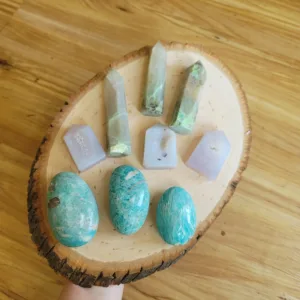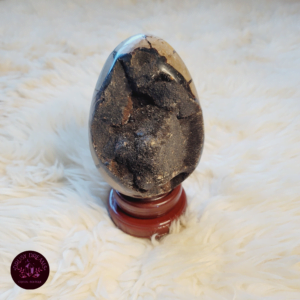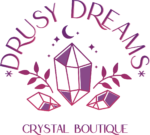
Ethical crystals have become quite a hot topic in the crystal world. And Chinese crystals get an especially bad rap. Yet the truth may surprise you…

As a shop owner I receive hundreds of messages from Chinese suppliers looking to sell their crystals. And they are everywhere on social media. Are they a good source? Most “ethical” suppliers would say no. Yet there is very little evidence or explanation why. I needed to know the truth for myself. Here, my goal is to share my findings, so that you can make your own educated decisions.
First of all, I will begin by sharing one fact that is all but ignored. If you read nothing else here, please take away this one piece of information: if you wear clothes made in China, own a computer, laptop, cellphone or tablet, or use any of the millions of items made in China, it is hypocritical to single out the Chinese crystal market. In fact, your computer contains far more blood money than any polished crystal. More on that below…
I have carried Chinese crystals in my shop…
…but it is not my preferred source. Through personal experience, I have found the quality is generally lower. Additionally, there is an obscene amount of fake and treated crystals. These include citrine, smoky quartz, Color enhanced fluorite, turquoise, amber, lab grown quartz clusters, Malachite, Opalite, “Fire quartz”, goldstone, the list goes on…. However, if you know how to avoid these, you will find they produce impeccable carvings, spheres and other polished shapes. And you can find decent quality, for fair prices. So Chinese wholesalers can be a good option, if you know your way around the market.
the most important thing I’ve learned: Just because crystals come from China, does not mean they originate in China. While China does mine some minerals, most is imported. And it is almost impossible to determine the origin. This can be concerning, as some of the countries they import from include those who employ child and forced labor.


Wait….Chinese crystals and child Labor?
This is a major concern, and not to be taken lightly. There is a very popular American crystal importer on social media whose major platform is fighting this issue. This is commendable. However, I have been unable to verify these claims (regarding Chinese crystals specifically), and this importer does not offer evidence, even when asked.
To be fair, we all know Chinese labor markets are questionable. Workers are paid very little for long hours, many in unsafe conditions. Yet regarding child labor specific to the crystal markets, there is little evidence. My research has taken me to many sources. perhaps the most concise is from the US Department of Labor – they keep a database of all known goods produced using child labor, forced labor, etc. You may view the complete list here.
To begin, narrow the search results to China. Here you will see listed electronics, textiles, toys, hair products, coal, solar panels, bricks, etc. Yet there is no mention of crystals or minerals, carving factories, or any mining operation besides coal. The sobering realization is this: the computer you are reading this on, our cellphones and TVs, even our clothing is much more guilty of forced child labor than Chinese crystals.
China imports crystals?
China does mine some of its own materials, including malachite, Fluorite, Rhodochrosite, Beryl, Nephrite, Jade, Calcite, Opal, etc. Yet they do import as well. I have seen minerals from Brazil, Madagascar, Indonesia, and Russia in the crystal markets, just to name a few. China has worked very hard to become a leader in the crystal marketplace, and they have become quite successful – they carry crystals from around the world, in any shape imaginable, for very low prices. This is a huge reason for their popularity as wholesalers. They are a one-stop shop.
The problem is the original source is usually lost. When asked, I have witnessed many sellers do a quick Google search. All Chinese sellers’ source from factories or large crystal markets, re-selling on social media platforms, Ali Express, Temu, etc. The “managers” and importers of these companies are impossible to contact. Referencing our list from the US Department of Labor, countries that use child labor include India, Colombia, Congo, Nigeria, Madagascar, Nepal, Uganda, Pakistan, etc. And there are crystals from these countries in the Chinese markets. This does not mean all minerals from these countries involve child labor, but it is impossible to rule out. To me, this is a concern.
Please note: My source for this information is based on my experiences with large scale crystal suppliers, who sell anything and everything. It is important to note there is a difference in specialty sources, such as those found on The Arkenstone. The founder, Dr. Robert Lavinsky is an expert on Chinese minerals. His gallery is an example of well sourced crystals from Chinese mines (although they are restricted to specimen quality with a price to match).


So, we shouldn’t buy Chinese crystals?
I do not believe this is necessary. China does have some good crystal deals, but you need to be knowledgeable to navigate the markets. If you are looking to purchase an item from China, here are some tips to help you succeed:
- Be educated – know about the crystals you are interested in, and what good quality looks like. One of my favorite sources is Mindat.org – a world renowned website with info on any mineral imaginable. Familiarize yourself with a new material before purchasing.
- Know possible origins – if you are concerned about child labor or conflict minerals, be aware of where these minerals come from. If sellers are forthcoming, you will be prepared. I personally do not buy any questionable materials through China (such as Lapis Lazuli), which avoids the problem entirely. Again, you can reference violating countries here.
- Be aware of fakes – they are everywhere in Chinese markets. A few examples are smoky quartz, citrine, malachite, Color enhanced fluorite, turquoise, amber, lab grown quartz clusters, Opalite, “Fire quartz”, goldstone, Bumblebee Jasper, and more. I avoid these materials entirely.
My Conclusions…
China can be a good source of crystals and minerals, but there is a lot to navigate. This includes low quality, possible unethical mining practices, and fakes. There is much to avoid, but with proper preparation it is possible to find good crystals in China, especially carvings. Arm yourself with knowledge and ask as many questions as possible. If you are purchasing from a local or online shop and have questions about a piece, ask! Any honest shop owner will be happy to share what they know about their crystals, even if they are from China.
Have you bought crystals from China? Share your experience below! 👇

